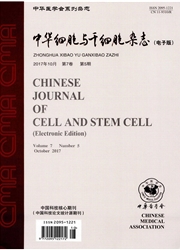

 中文摘要:
中文摘要:
目的探讨RNAi技术体外抑制MuRF-1或FOXO3a基因表达的效果,为RNAi介导的失神经骨骼肌萎缩基因治疗奠定基础。方法体外培养大鼠成肌细胞系L6,将MuRF-1和(或)FOXO3asiRNA重组质粒在Lipofectamine2000介导下转染,优化与检测系统的转染效率;将2ggMuRF-1或FOXO3a基因siRNA重组质粒转染L6,转染后48h与72h,采用实时定量PCR检测siRNA重组质粒对MuRF-1和F0xO3a的mRNA的抑制效果,使用Western印迹检测siRNA重组质粒对MuRF-1和FOXO3a蛋白水平的抑制效果。用单因素方差分析方法和LSD法进行组问比较。结果(1)质粒转染后24h,荧光显微镜下可见细胞中有大量明亮的绿色荧光表达,显示系统有较高的转染效率。(2)实时定量PCR分析结果显示:MuRF-1与FOXO3a各自的siRNA重组质粒转染后48h,二者干扰序列在mRNA水平分别明显抑制了MuRF-1和FOXO3a的表达,抑制率达67%和54%,与对照组相比差异均有统计学意义(P〈0.05),联合MuRF-1与FOXO3a两基因siRNA重组质粒转染后48h,干扰序列在mRNA水平明显抑制了MuRF-1及FOXO3a的表达,抑制率达61%及58%,与对照组相比差异有统计学意义(P〈0.05);转染后72h,MuRF-1与FOXO3a各自的siRNA重组质粒干扰序列对MuRF-1和FOXO3a的mRNA的抑制率分别达79%和81%,联合MuRF-1与FOXO3a两基因siRNA重组质粒干扰序列对MuRF-1和FOXO3a的mRNA的抑制率达77%及72%,与对照组相比差异均有统计学意义(P〈0.05),与48h相比,抑制效应更为明显。(3)Western印迹灰度分析结果显示:转染后48h,干扰序列MuRF-1明显抑制了MuRF-1蛋白的表达,抑制率达61%,与对照组相比差异有统计学意义(P〈0.05),干扰序列FOXO3a明显抑制了FOXO3a蛋白的表达,抑制率达46%,与对照组相比差异有统计学意义(P〈0.05),联合MuRF-1与FOXO3a两基因siRNA重组质粒干扰序列对MuRF-1和FOXO3a蛋白表达的抑制率达64?
 英文摘要:
英文摘要:
Objective To investigate the effect of RNAi technology in inhibiting gene expression of MuRF-1 or FOXO3a in vitro, establishing a foundation for RNAi mediated gene therapy for denervated skeletal muscle atrophy. Methods Rat muscle cell line L6 was transfected with MuRF-1 or FOXO3a siRNA plasmid using Lipofectamine 2000. After transfection was optimized, 2 pg of MuRF-1 or FOXO3a siRNA recombinant plasmid was transfted. At 48 h and 72 h after transfection, the real-time quantitative PCR was used to detect the inhibition effect of MuRF-1 and FOXO3a. Protein level was evaluated using Western blotting. Results (1) At 24 h after transfection, strong bright green fluorescence was observed under fluorescence microscopy, indicating high transfection efficiency. (2) Real time quantitative PCR analysis showed mRNA expression was significantly inhibited for both MuRF-1 and FOXO3a after 48 h, with an inhibition rate of 67 % and 54 % respectively. When MuRF- 1 and FOXO3a siRNA recombinant plasmids were co-transfectied, MuRF-1 and FOXO3a expression was inhibite by 61% and 58 % respectively compared with the control (P 〈 0.05 for both). At 72 h after transfection, the inhibitory rates for MuRF-1 and FOXO3a siRNA recombinant plasmids at mRNA level were 79 % and 81% respectively. When MuRF-1 and FOXO3a siRNA recombinant plasmids were co-transfected, MuRF-1 and FOXO3a mRNA was inhibited by 77 % and 72 % respectively, significantly higher than the control group (P 〈 0.05) and higher than that at 48 h. (3) Western blotting showed MuRF-1 and FOXO3a were inhibited by 61% and 46 % respectively. When MuRF-1 and FOXO3a siRNA recombinant plasmids were co-transfected, MuRF-1 and FOXO3a protein expression was inhibited by 64 % and 42 % respectively, both higher than the control (P 〈 0.05). At 72 h, MuRF-1 and FOXO3a protein expression was inhibited by 70% and 72% respectively, significantly greater than the control. Whenunited MuRF-1 and FOXO3a siRNA recombinant plasmids were co-transfected, MuRF-1 and FOXO3a in
 同期刊论文项目
同期刊论文项目
 同项目期刊论文
同项目期刊论文
 期刊信息
期刊信息
